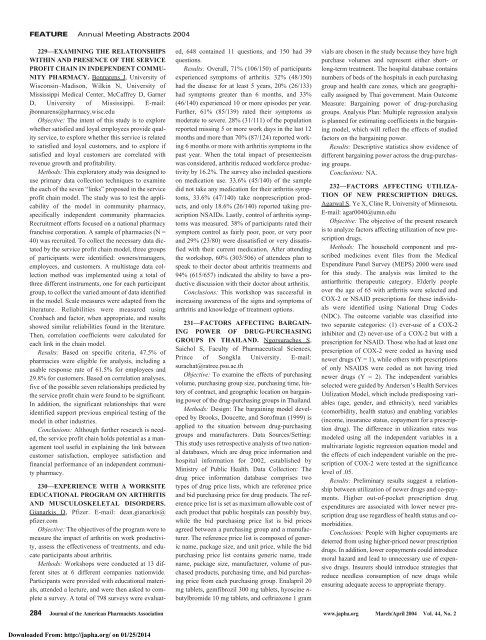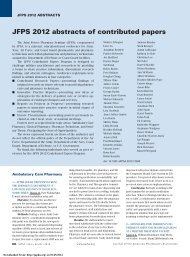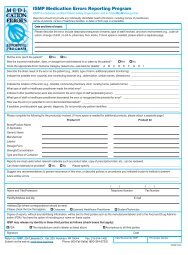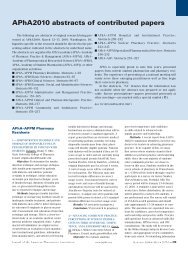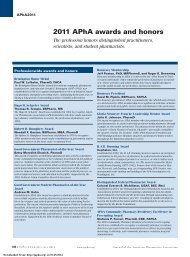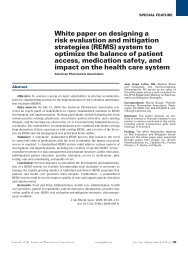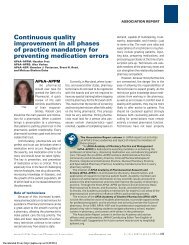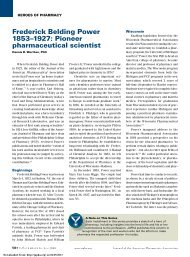Downloaded - Journal of American Pharmacists Association
Downloaded - Journal of American Pharmacists Association
Downloaded - Journal of American Pharmacists Association
Create successful ePaper yourself
Turn your PDF publications into a flip-book with our unique Google optimized e-Paper software.
FEATURE Annual Meeting Abstracts 2004<br />
229—EXAMINING THE RELATIONSHIPS<br />
WITHIN AND PRESENCE OF THE SERVICE<br />
PROFIT CHAIN IN INDEPENDENT COMMU-<br />
NITY PHARMACY. Bonnarens J, University <strong>of</strong><br />
Wisconsin–Madison, Wilkin N, University <strong>of</strong><br />
Mississippi Medical Center, McCaffrey D, Garner<br />
D, University <strong>of</strong> Mississippi. E-mail:<br />
jbonnarens@pharmacy.wisc.edu<br />
Objective: The intent <strong>of</strong> this study is to explore<br />
whether satisfied and loyal employees provide quality<br />
service, to explore whether this service is related<br />
to satisfied and loyal customers, and to explore if<br />
satisfied and loyal customers are correlated with<br />
revenue growth and pr<strong>of</strong>itability.<br />
Methods: This exploratory study was designed to<br />
use primary data collection techniques to examine<br />
the each <strong>of</strong> the seven “links” proposed in the service<br />
pr<strong>of</strong>it chain model. The study was to test the applicability<br />
<strong>of</strong> the model in community pharmacy,<br />
specifically independent community pharmacies.<br />
Recruitment efforts focused on a national pharmacy<br />
franchise corporation. A sample <strong>of</strong> pharmacies (N =<br />
40) was recruited. To collect the necessary data dictated<br />
by the service pr<strong>of</strong>it chain model, three groups<br />
<strong>of</strong> participants were identified: owners/managers,<br />
employees, and customers. A multistage data collection<br />
method was implemented using a total <strong>of</strong><br />
three different instruments, one for each participant<br />
group, to collect the varied amount <strong>of</strong> data identified<br />
in the model. Scale measures were adapted from the<br />
literature. Reliabilities were measured using<br />
Cronbach and factor, when appropriate, and results<br />
showed similar reliabilities found in the literature.<br />
Then, correlation coefficients were calculated for<br />
each link in the chain model.<br />
Results: Based on specific criteria, 47.5% <strong>of</strong><br />
pharmacies were eligible for analysis, including a<br />
usable response rate <strong>of</strong> 61.5% for employees and<br />
29.8% for customers. Based on correlation analyses,<br />
five <strong>of</strong> the possible seven relationships predicted by<br />
the service pr<strong>of</strong>it chain were found to be significant.<br />
In addition, the significant relationships that were<br />
identified support previous empirical testing <strong>of</strong> the<br />
model in other industries.<br />
Conclusions: Although further research is needed,<br />
the service pr<strong>of</strong>it chain holds potential as a management<br />
tool useful in explaining the link between<br />
customer satisfaction, employee satisfaction and<br />
financial performance <strong>of</strong> an independent community<br />
pharmacy.<br />
230—EXPERIENCE WITH A WORKSITE<br />
EDUCATIONAL PROGRAM ON ARTHRITIS<br />
AND MUSCULOSKELETAL DISORDERS.<br />
Gianarkis D, Pfizer. E-mail: dean.gianarkis@<br />
pfizer.com<br />
Objective: The objectives <strong>of</strong> the program were to<br />
measure the impact <strong>of</strong> arthritis on work productivity,<br />
assess the effectiveness <strong>of</strong> treatments, and educate<br />
participants about arthritis.<br />
Methods: Workshops were conducted at 13 different<br />
sites at 6 different companies nationwide.<br />
Participants were provided with educational materials,<br />
attended a lecture, and were then asked to complete<br />
a survey. A total <strong>of</strong> 798 surveys were evaluated,<br />
648 contained 11 questions, and 150 had 39<br />
questions.<br />
Results: Overall, 71% (106/150) <strong>of</strong> participants<br />
experienced symptoms <strong>of</strong> arthritis. 32% (48/150)<br />
had the disease for at least 5 years, 20% (26/133)<br />
had symptoms greater than 6 months, and 33%<br />
(46/140) experienced 10 or more episodes per year.<br />
Further, 61% (85/139) rated their symptoms as<br />
moderate to severe. 28% (31/111) <strong>of</strong> the population<br />
reported missing 5 or more work days in the last 12<br />
months and more than 70% (87/124) reported working<br />
6 months or more with arthritis symptoms in the<br />
past year. When the total impact <strong>of</strong> presenteeism<br />
was considered, arthritis reduced workforce productivity<br />
by 16.2%. The survey also included questions<br />
on medication use. 33.6% (45/140) <strong>of</strong> the sample<br />
did not take any medication for their arthritis symptoms,<br />
33.6% (47/140) take nonprescription products,<br />
and only 18.6% (26/140) reported taking prescription<br />
NSAIDs. Lastly, control <strong>of</strong> arthritis symptoms<br />
was measured. 38% <strong>of</strong> participants rated their<br />
symptom control as fairly poor, poor, or very poor<br />
and 29% (23/80) were dissatisfied or very dissatisfied<br />
with their current medication. After attending<br />
the workshop, 60% (303/506) <strong>of</strong> attendees plan to<br />
speak to their doctor about arthritis treatments and<br />
94% (615/657) indicated the ability to have a productive<br />
discussion with their doctor about arthritis.<br />
Conclusions: This workshop was successful in<br />
increasing awareness <strong>of</strong> the signs and symptoms <strong>of</strong><br />
arthritis and knowledge <strong>of</strong> treatment options.<br />
231—FACTORS AFFECTING BARGAIN-<br />
ING POWER OF DRUG-PURCHASING<br />
GROUPS IN THAILAND. Ngorsuraches S,<br />
Saichol S, Faculty <strong>of</strong> Pharmaceutical Sciences,<br />
Prince <strong>of</strong> Songkla University. E-mail:<br />
surachat@ratree.psu.ac.th<br />
Objective: To examine the effects <strong>of</strong> purchasing<br />
volume, purchasing group size, purchasing time, history<br />
<strong>of</strong> contract, and geographic location on bargaining<br />
power <strong>of</strong> the drug-purchasing groups in Thailand.<br />
Methods: Design: The bargaining model developed<br />
by Brooks, Doucette, and Sor<strong>of</strong>man (1999) is<br />
applied to the situation between drug-purchasing<br />
groups and manufacturers. Data Sources/Setting:<br />
This study uses retrospective analysis <strong>of</strong> two national<br />
databases, which are drug price information and<br />
hospital information for 2002, established by<br />
Ministry <strong>of</strong> Public Health. Data Collection: The<br />
drug price information database comprises two<br />
types <strong>of</strong> drug price lists, which are reference price<br />
and bid purchasing price for drug products. The reference<br />
price list is set as maximum allowable cost <strong>of</strong><br />
each product that public hospitals can possibly buy,<br />
while the bid purchasing price list is bid prices<br />
agreed between a purchasing group and a manufacturer.<br />
The reference price list is composed <strong>of</strong> generic<br />
name, package size, and unit price, while the bid<br />
purchasing price list contains generic name, trade<br />
name, package size, manufacturer, volume <strong>of</strong> purchased<br />
products, purchasing time, and bid purchasing<br />
price from each purchasing group. Enalapril 20<br />
mg tablets, gemfibrozil 300 mg tablets, hyoscine n-<br />
butylbromide 10 mg tablets, and ceftriaxone 1 gram<br />
vials are chosen in the study because they have high<br />
purchase volumes and represent either short- or<br />
long-term treatment. The hospital database contains<br />
numbers <strong>of</strong> beds <strong>of</strong> the hospitals in each purchasing<br />
group and health care zones, which are geographically<br />
assigned by Thai government. Main Outcome<br />
Measure: Bargaining power <strong>of</strong> drug-purchasing<br />
groups. Analysis Plan: Multiple regression analysis<br />
is planned for estimating coefficients in the bargaining<br />
model, which will reflect the effects <strong>of</strong> studied<br />
factors on the bargaining power.<br />
Results: Descriptive statistics show evidence <strong>of</strong><br />
different bargaining power across the drug-purchasing<br />
groups.<br />
Conclusions: NA.<br />
232—FACTORS AFFECTING UTILIZA-<br />
TION OF NEW PRESCRIPTION DRUGS.<br />
Agarwal S, Ye X, Cline R, University <strong>of</strong> Minnesota.<br />
E-mail: agar0040@umn.edu<br />
Objective: The objective <strong>of</strong> the present research<br />
is to analyze factors affecting utilization <strong>of</strong> new prescription<br />
drugs.<br />
Methods: The household component and prescribed<br />
medicines event files from the Medical<br />
Expenditure Panel Survey (MEPS) 2000 were used<br />
for this study. The analysis was limited to the<br />
antiarthritic therapeutic category. Elderly people<br />
over the age <strong>of</strong> 65 with arthritis were selected and<br />
COX-2 or NSAID prescriptions for these individuals<br />
were identified using National Drug Codes<br />
(NDC). The outcome variable was classified into<br />
two separate categories: (1) ever-use <strong>of</strong> a COX-2<br />
inhibitor and (2) never-use <strong>of</strong> a COX-2 but with a<br />
prescription for NSAID. Those who had at least one<br />
prescription <strong>of</strong> COX-2 were coded as having used<br />
newer drugs (Y = 1), while others with prescriptions<br />
<strong>of</strong> only NSAIDS were coded as not having tried<br />
newer drugs (Y = 2). The independent variables<br />
selected were guided by Andersen’s Health Services<br />
Utilization Model, which include predisposing variables<br />
(age, gender, and ethnicity), need variables<br />
(comorbidity, health status) and enabling variables<br />
(income, insurance status, copayment for a prescription<br />
drug). The difference in utilization rates was<br />
modeled using all the independent variables in a<br />
multivariate logistic regression equation model and<br />
the effects <strong>of</strong> each independent variable on the prescription<br />
<strong>of</strong> COX-2 were tested at the significance<br />
level <strong>of</strong> .05.<br />
Results: Preliminary results suggest a relationship<br />
between utilization <strong>of</strong> newer drugs and co-payments.<br />
Higher out-<strong>of</strong>-pocket prescription drug<br />
expenditures are associated with lower newer prescription<br />
drug use regardless <strong>of</strong> health status and comorbidities.<br />
Conclusions: People with higher copayments are<br />
deterred from using higher-priced newer prescription<br />
drugs. In addition, lower copayments could introduce<br />
moral hazard and lead to unnecessary use <strong>of</strong> expensive<br />
drugs. Insurers should introduce strategies that<br />
reduce needless consumption <strong>of</strong> new drugs while<br />
ensuring adequate access to appropriate therapy.<br />
284 <strong>Journal</strong> <strong>of</strong> the <strong>American</strong> <strong>Pharmacists</strong> <strong>Association</strong> www.japha.org March/April 2004 Vol. 44, No. 2<br />
<strong>Downloaded</strong> From: http://japha.org/ on 01/25/2014


